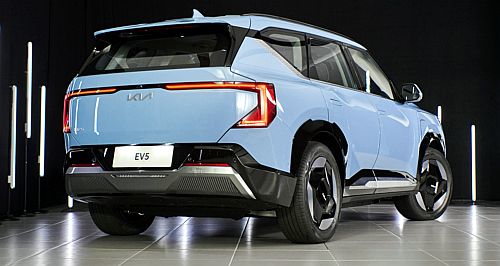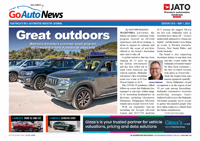Make / Model Search
Future models - Kia - EV5For Oz: Kia EV5 development detailedKia EV5 program has seen no stone left unturned in order to succeed in Australia4 Apr 2024 KIA Australia is gearing up to launch what could be its most important passenger car in recent memory, the EV5 electric SUV.
The all-new model is similar in size and will play in the same segment as the Sportage SUV, but with a fully electric powertrain and a very different approach to its production and engineering process compared with its sister model.
That is because the EV5 has been developed and will be built in China, instead of South Korea. And it will also make use of Chinese EV specialist brand BYD’s battery technology, too.
But just because the program is coming from a new source does not mean that Kia Australia has not had its hands all over the project.
In fact, according to Kia Australia chief ride and handling engineer, Graeme Gambold, the new product might actually be the best suited vehicle for our needs, because of the level of attention and importance it has for the brand more broadly.
“The commitment from Kia and this particular model is huge,” he said.
“As you know it is going to be manufactured in China, in southern China. But on top of that, there is a new R&D centre that Kia has built in Yantai in China, across from Seoul,” he said.
“And that is a whole proving ground that is basically a copy and paste of Namyang. It has all its own engineers, a proving ground all ticked off by Albert Biermann, and correlation between the two.
“So, the technical capacity of that research centre is the same as Namyang, except it is only for – at the moment – for us, it is only for EV5,” said Mr Gambold, who is leading the Australia-specific ride and handling tune for the electric SUV.
“We had a red-carpet experience when we went up there because we were the only client. Whereas in Namyang, there are so many global models being made, we squeeze into the workshop, work on ours, and it is ‘see you later’ sort of thing.
“But everything was there for us. They just opened doors to everything, helped us out, worked together, and we made the car as good as we thought we needed it to be, or as good as we could.
“Absolute total support – unique parts rushed into production – and we have never seen a commitment to the model program like that.
“That is probably where the world’s going in terms of everybody committing big programs to EVs, but it is our first experience to have such a level of attention to a project of ours,” he admitted.
“And then after we did all our ride and handling both up there and back here, engineers still kept coming out from China and only just finished, checking things like calibrating the ADAS stuff to our roads, road signs and our conditions.”
The brand has also done extensive testing on the car with local charging infrastructure across the ACT and in New South Wales, not to mention tailoring any software solutions for the Kia Connect data system.
“The commitment from the Chinese has been huge,” he said.
“I thought they might be a little bit short... (on) some of the technology, but the vehicle dynamics knowledge and expertise is cutting edge.
“There is no associated quality downturn. In actual fact, I think that this car is better for the fact that it is made out of China and it has got all this extra attention (as opposed to a Korean-made_ normal product.”
Mr Gambold pointed out that, having worked with different types of battery chemistry in other EV programs – EV6 and EV9, for instance, which run lithium-ion NMC batteries, which are lighter but potentially less durable long term – he found the difference with the new EV5 noticeable.
That is because the EV5 uses BYD Blade batteries, using LFP (lithium iron-phosphate) chemistry, which is more affordable and potentially more durable when it comes to repeatedly charging to full capacity.
“There are pros and cons. It lowers the cost, increases the weight, but it improves the charging situation – full charge it all the time, and it is a little bit safer.
“It is not an inferior technology at all, even though it is about keeping the cost down, it is seen as, possibly, that. But it is not at all.”
The EV5 range is set to kick of below $60,000, according to Kia Australia, which would mean it would “undercut the Model Y” from Tesla – a stated aim from the brand’s product planning team.
The EV5 will be offered in three trim grades – Air, Earth and GT-Line – with front- and all-wheel drive options available, and two battery size options on offer.
Full detailed specification and pricing are due before the vehicle’s launch in June 2024.  All future models Alfa Romeo Alfa Romeo Abarth Abarth Alpine Alpine Alpina Alpina Audi Audi Aston Martin Aston Martin BMW BMW Bentley Bentley Chery Chery Brabham Brabham Chrysler Chrysler Chevrolet Chevrolet Cupra Cupra Citroen Citroen DS DS Dodge Dodge Fiat Fiat Ferrari Ferrari Foton Foton Ford Ford Great Wall Great Wall FPV FPV Haval Haval GWM GWM Honda Honda Holden Holden Hummer Hummer HSV HSV Infiniti Infiniti Hyundai Hyundai Jaguar Jaguar Isuzu Isuzu Kia Kia Jeep Jeep Land Rover Land Rover Lamborghini Lamborghini Lexus Lexus LDV LDV Mahindra Mahindra Lotus Lotus Mazda Mazda Maserati Maserati Mercedes-AMG Mercedes-AMG McLaren McLaren MG MG Mercedes-Benz Mercedes-Benz Mitsubishi Mitsubishi Mini Mini Opel Opel Nissan Nissan Peugeot Peugeot Pagani Pagani Proton Proton Porsche Porsche Renault Renault Ram Ram Rover Rover Rolls-Royce Rolls-Royce Skoda Skoda Saab Saab SsangYong SsangYong Smart Smart Suzuki Suzuki Subaru Subaru Toyota Toyota Tesla Tesla Volvo VolvoMotor industry news |
Click to shareKia modelsResearch Kia All future models Alfa Romeo Alfa Romeo Abarth Abarth Alpine Alpine Alpina Alpina Audi Audi Aston Martin Aston Martin BMW BMW Bentley Bentley Chery Chery Brabham Brabham Chrysler Chrysler Chevrolet Chevrolet Cupra Cupra Citroen Citroen DS DS Dodge Dodge Fiat Fiat Ferrari Ferrari Foton Foton Ford Ford Great Wall Great Wall FPV FPV Haval Haval GWM GWM Honda Honda Holden Holden Hummer Hummer HSV HSV Infiniti Infiniti Hyundai Hyundai Jaguar Jaguar Isuzu Isuzu Kia Kia Jeep Jeep Land Rover Land Rover Lamborghini Lamborghini Lexus Lexus LDV LDV Mahindra Mahindra Lotus Lotus Mazda Mazda Maserati Maserati Mercedes-AMG Mercedes-AMG McLaren McLaren MG MG Mercedes-Benz Mercedes-Benz Mitsubishi Mitsubishi Mini Mini Opel Opel Nissan Nissan Peugeot Peugeot Pagani Pagani Proton Proton Porsche Porsche Renault Renault Ram Ram Rover Rover Rolls-Royce Rolls-Royce Skoda Skoda Saab Saab SsangYong SsangYong Smart Smart Suzuki Suzuki Subaru Subaru Toyota Toyota Tesla Tesla Volvo VolvoMotor industry news |









Facebook Twitter Instagram